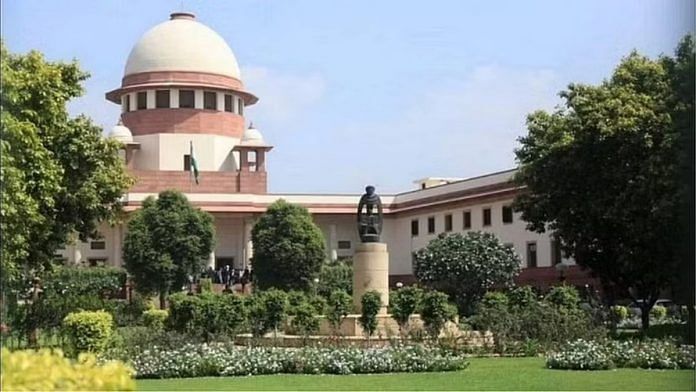New Delhi: The Supreme Court Thursday emphasised the need to maintain a balance between development and preservation of ecology and set aside the National Green Tribunal’s (NGT) two orders that imposed fetters on the Himachal Pradesh government, restraining it from proceeding with development work in the Shimla Planning Area (SPA).
A bench led by Justice B.R. Gavai faulted the NGT for directing the state to enact regulations in a particular manner and observed: “We are of the considered view that the NGT could not have directed the delegatee (Himachal government), who has been delegated with powers by the competent legislature, which has been done under a law.”
One of the two quashed NGT orders dates back to November 2017, while the other to October 2022.
Though the bench has asked the Himachal Pradesh government to move with its development plan for 22,459 hectares of SPA, it added that its judgment should not be construed as a court’s approval or “stamp” to all the provisions made in the development plan.
“In that regard, if any person feels aggrieved by any of the provisions, they would always be at liberty to take recourse to such remedy as is available in law,” the court said.
It, however, added: “It can be seen that, while preparing the development plan, due care has been taken to ensure that environmental aspects are taken care of.”
The NGT’s October 2022 was held to be not in “conformity with the principles of judicial propriety.” The apex court said the tribunal should not have continued with the proceedings while an appeal against one of its interim orders related to the matter was pending before the Himachal Pradesh High Court.
Given the “settled position of law,” the apex court said high courts exercise the power of judicial review over all tribunals that are situated within its jurisdiction. Moreover, “obedience (to maintain hierarchy) would also be conducive to their smooth working,” otherwise it would result in confusion in the administration of law, the SC added.
Also Read: Is AMU a minority institution? Roots of 6-decade-old dispute & why it’s come up in SC again
What did the two orders say?
The judgment was delivered on Himachal Pradesh government’s appeals against the two orders.
The NGT’s November 2017 decision saw various directions issued to the state, which included a ban on all kinds of construction activities in core, forest and green areas in Shimla. It further restricted construction and reconstruction activities in the entire SPA.
The directions also restricted the reconstruction of unsafe and unfit residential structures in core, green and forest areas to a two-storey building with an attic floor.
The 2017 direction gave three months to the state to finalise the development plan and ordered the construction of an implementation and a supervisory committee, which was entrusted with the responsibility of carrying out the specific directions.
While the state’s appeal against this order was pending before the top court, the state published a draft development plan on 8 February, 2022.
This plan was questioned before the NGT by the same petitioner on whose plea the tribunal had issued the 2017 directions. The tribunal stayed the draft development plan and stopped the state from taking any further steps.
Aggrieved with the stay order, the state approached the Himachal Pradesh High Court. Despite the issue pending before the HC, the NGT in October 2022 declared that the draft development plan was in conflict with its first order, was illegal and could not be given effect.
Since the top court was hearing the state’s appeal against NGT’s 2017 order, it transferred to itself the case filed in the Himachal Pradesh HC on the draft development plan.
Pursuant to the SC’s transfer order, the state notified the final development plan on 20 June, 2023, and submitted it to the apex court.
‘Developmental activities important to meet demands’
While setting aside the NGT’s orders, SC Thursday noted that the Himachal Pradesh government had received 97 objections to the draft development plan and an opportunity was given to all before it was finalised. The court was told that all, except five objectors, had requested the state for more relaxation in the building bylaws in SPA.
The court took note of some key features of the development plan that provide for construction only in those plots where there are no trees and envisages and gives preference to vertical construction over horizontal, which would make room for more open spaces.
According to the plan, construction in green belt areas would be permitted only to the extent of single storeys with attics, and restricted for residential use only. One of the two floors would be reserved for parking. The plan prohibits felling of trees and change of land use as well. A detailed provision has been made for heritage land use as well as core and non-core areas, it was said in court.
The bench also learnt that a soil investigation report would be required before the construction or reconstruction of buildings in areas falling in sinking and sliding zones of SPA.
Upon a prima facie consideration of the development plan, the court observed the same was finalised taking into account reports of various expert committees and studies with regard to various aspects, including environmental and ecological aspects.
“There are sufficient safeguards to balance the need for development while taking care of and addressing the environmental concerns,” said the court, adding that the finalisation of the development plan was pursuant to a rigorous process, including inviting objections and hearing the objectors.
“..in our view, the development plan, which has been finalised after taking recourse to the statutory provisions and undergoing the rigours thereto, cannot be stalled in entirety, thereby putting the entire developmental activities to a standstill,” the court said, noting developmental activities were important to meet demands of a growing population.
(Edited by Richa Mishra)
Also Read: 9 months after NGT order, Haryana govt works on policy to curb tree felling in non-forest areas



